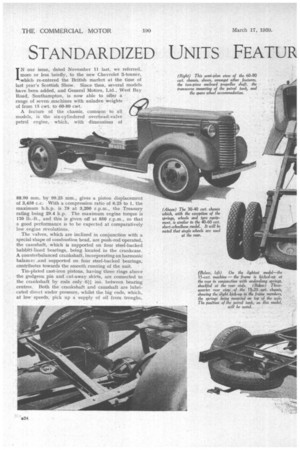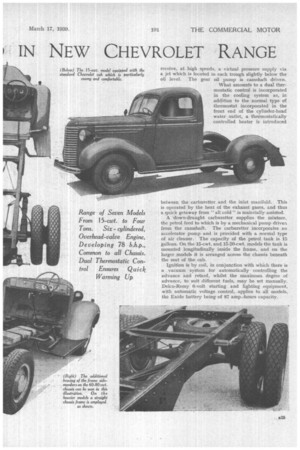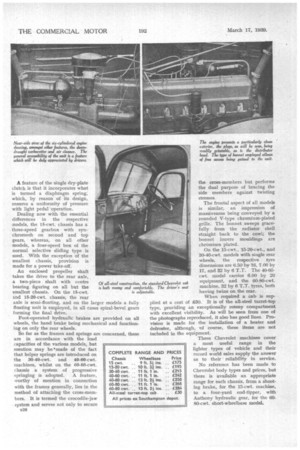STANDARDIZED UNITS FEATUR IN NEW CHEVROLET RANGE
Page 42

Page 43

Page 44

If you've noticed an error in this article please click here to report it so we can fix it.
IN our issue, dated November 11 last, we referred, more or less briefly, to the new Chevrolet 3-tonner, which re-entered the British market at the time of last year's Scottish Show. Since then, several models have been added, and General Motors, Ltd., West Bay Road, Southampton, is now able to _offer a range of seven machines with unladen weights of from 15 cwt. to 60-80 cwt.
A feature of the chassis, common to all models, is the six-eylindered overhead-valve petrol engine, which, with dimensions of
88.90 mm. by 99.25. mm., gives a piston displacement of 3,458 c.c. With a compression ratio of 6.25 to I, the maximum b.h.p. is 78 at 3200, r.p.m., the Treasury rating being 29.4 h.p. The maximum engine torque is 170 lb.-ft., and this is given off at 850 r.p.m., so that a good performance is to he expected at comparatively low engine revolutions.
The valves, which are inclined in conjunction with a special shape of combustion head, are push-rod operated, the camshaft, which is supported on four steel-backed babbitt-lined bearings, being located in the crankcase, A counterbalanced crankshaft, incorporating an harmonic balancer .and supported on four steel-backed bearings, contributes towards the smooth running of the unit. • Tin-plated cast-iron pistons, having three rings above the gudgeon pin and cut-away skirts, are connected to the crankshaft by rods only 6-N. ins between bearing centres. Both the crankshaft and camshaft are lubricated direct under pressure, whilst the big ends, which, at low speeds, pick up a supply of oil from troughs, receive, at high speeds, a virtual pressure supply via a jet which is located in each trough slightly below the oil level. The gear oil pump is camshaft driven.
What amounts to a dual thermostatic control is incorporated in the cooling system as, in addition to the normal type of thermostat incorporated in the front end of the cylinder-head water . outlet, a. thermostatically controlled heater is introduced between the carburetter and the inlet manifold. This is operated by the heat of the exhaust gases, and thus a quick getaway from "all cord" is materially assisted.
A down-draught carburetter supplies the mixture, the petrol feed to which is by a mechanical pump driven from the camshaft. The carburetter incorporates an accelerator pump and is provided with a nornial type of air cleaner. The capacity of the petrol tank is 15 gallons. On the 15-cwt. and 15-20-cwt. models the tank is mounted longitudinally inside the frame, and on the larger models it is arranged across the chassis beneath the seat of the cab.
Ignition is by coil, in conjunction with which there is a vacuum system for automatically controlling the advance and retard, whilst the maximum degree of advance, to suit different fuels, may be set manually. Delco-Remy 6-volt starting and lighting equipment, with automatic voltage control, applies to all models, the Exide battery being of 87 amp.-hours capacity. A feature of the single dry-plate clutch is that it incorporates what is termed a diaphragm spring, which, by reason of its design, ensures a uniformity of pressure with light pedal operation.
Dealing now with the essential differences in the respective models, the 15-cwt. chassis has a three-speed gearbox with synchromesh on second and top gears, whereas, on all other models, a four-speed box of the normal selective sliding type is used. With the exception of the smallest chassis, provision is made for a power take-off.
An enclosed propeller shaft takes the drive to the rear axle, a two-piece shaft with centre bearing figuring on all but the smallest chassis. On the 15-cwt. and 15-20-cwt. chassis, the rear axle is semi-floating, and on the larger models a fully floating unit is employed, in all cases spiral-bevel gears forming the final drive.
Foot-operated hydraulic brakes are provided on all wheels, the hand brake being mechanical and functioning on only the rear wheels.
So far as the frames and springs are concerned, these are in accordance with the load capacities of the various models, but mention may be Inaade of the fact that helper springs are introduced on the 30-40-cwt. and 40-60-cwt. machines, whilst on the 60-80-cwt. chassis a system of progressive springing is adopted. A feature, worthy of mention in connection with the frames generally, lies in the method of attaching the cross-members. It is termed the crocodile-jaw system and serves not only to secure B26 the cross-members but performs the dual purpose of bracing the side members against twisting stresses.
The frontal aspect of all models is similar, an impression of massiveness being conveyed by a rounded V-type chromium-plated grille. The bonnet sweeps gracefully from, the radiator shell • str,aight back to the cowl; the bonnet louvre mouldings are chromium plated.
On the 15-cwt., 15-20-cwt., and 30-40-cwt. models with single rear wheels, the respective tyre dimensions are 6.50 by 16, 7.00 by 17, and 32 by 6 T.T. The 40-60cwt. model carries 6.00 by 20 equipment, and the 60-80-cwt. machine, 32 by 6 T.T..tyres, both having twins on the rear.
When required a cab is supcost of £30. It is of the all-steel turret-top type, providing an exceptionally roomy compartment with excellent visibility. As will be seen from one of the photographs reproduced, it also has good lines. Provision is made for the installation of a heater and defroster, although, of course, these included in the equipment. plied at a items are not These Chevrolet machines cover a most useful range in the lighter types of vehicle and their record world sales supply the answer as to their reliability in service.
No reference has been made to Chevrolet body types and prices, but there is available an appropriate range for each chassis, from a shooting :brake, for the 15-cwt. machine, to a four-yard end-tipper, with Anthony hydraulic gear, for the 6080.-cwt. short-wheelbase model.




















































































